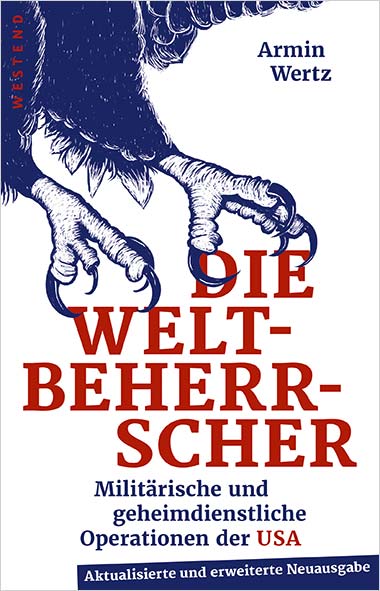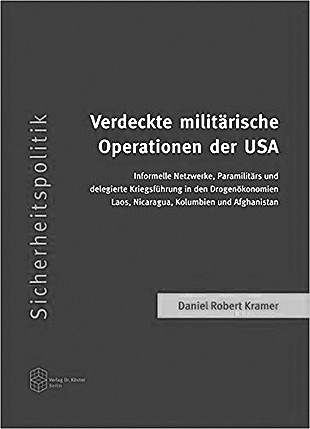Criminal aspects of US foreign policy
Two books which provide information
by Dr Matin Baraki, University of Marburg
Daniel Robert Kramer has published a highly topical and explosive book on US covert military operations. “Informal networks, paramilitaries and delegated warfare in the drug economies of Laos, Nicaragua, Colombia and Afghanistan” is the subtitle of this fascinating 275-page work. Having read the book, you are well informed, but also sad, indignant and somehow helpless. And that because ever since the Second World War (p. 11), a great power has been causing worldwide havoc and there is nobody who can do anything about it. The USA should actually have long ago been summoned to appear before the International Court of Justice in The Hague.
As early as in the 1960s and 1970s, during its covert war against the small neutral Southeast Asian country of Laos, the USA gained experience for its cooperation with warlords and drug barons. The CIA was in charge. From the beginning of 1962, it built two large military bases there and moved its headquarters to Long Tieng (p. 35). Thus Laos became the main base for the CIA in Southeastern Asia. Against the background of the US war against Vietnam, the CIA increased the number of its agents in Laos to 50,000 (p. 38) and massively intensified US bombing. Napalm bombs were used and many villages were completely destroyed (p. 44). The war was co-ordinated by the US embassy in Laos, by paramilitary forces of the CIA, special forces of the army and employees of the US development organisation “United States Agency for International Development” (USAID) (p. 45). Later, the US embassy in Vietnam took over control. “While around 128,000 tons of bombs had been dropped on Laos in 1967, bombing had already increased to almost 240,000 tons by the following year” (p. 49). The USA negotiated with Vietnam about ending the war, at the same time the CIA was “directly authorised by the US President” (p. 65) to circumvent the terms of the Geneva Agreement. Afterwards, the experience gained by this crime in Indochina were fully taken into account in Nicaragua against the Sandinists (pp. 71–117) and in Colombia (pp. 119–171). US methods of financing these wars included drug trafficking and arms deals, even with the “arch-enemy”, i.e. the Islamic Republic of Iran (see “Iran-Contra-Affair”, pp. 90-92); and they also asked their strategic allies for money. Saudi Arabia alone “had about 32 million US dollars transferred to the Contras” (p. 93). Help also came from the “chosen Holy Land”. “In the 1980s Israeli ex-militaries” (p. 133) were commissioned to set up paramilitary units for the USA.
In the last part of his book Daniel R. Kramer deals in detail with the covert US war against Afghanistan (pp. 173–256). Since 1978 the CIA began to train the Afghan Islamic terror groups, disguised as Mujahideen (holy warriors). Saudi Arabia helped with the ideological instruction and Pakistan with the military training. In July 1979 the then US President Jimmy Carter ordered US support of the Mujahideen. From 1980 this support developed into “one of the largest CIA operations in the history of the intelligence service” (p. 176). Since the war against Afghanistan was waged from Pakistan territory, the Pakistani dictator, General Zia Ulhaq, received “3.2 billion US dollars” (p. 178) “in the course of six years” from the USA. At the beginning of January 1980, the United States sent the first ships with weapons to Pakistan. From the 1960s the country had also received weapons sent from Egypt. These were of Soviet production, in the value of “about 15 million US dollars […]”, and brought from Cairo to Pakistan by US aircraft (p. 178). From this time on, the cultivation of opium was expanded in the areas controlled by the Mujahideen. The CIA installed laboratories in Pakistan, where the Islamists processed opium into heroin. This was said to finance the war against Afghanistan. In fact, the US and Pakistani secret services as well as the Islamist leadership benefited most.
“In April 1985” the US President of that time, Ronald Reagan, “issued Directive 166 […], which instructed the CIA to use all available means to combat the Soviets” in Afghanistan (pp. 180). Therefore at the end of 1985, the budget of the CIA was “increased to half a billion US dollars per annum” (p. 181). From 1979 to 1989 the CIA handed over weapons worth 3 billion US dollars to the Islamists. While at the beginning of 1980, they had received weapons for about 30 million US dollars, at the end of the year the sum increased “to 700 million annually” (p. 182). Every year, 65,000 tons of weapons were brought to Pakistan for the war against Afghanistan.
Of the six Islamist groups operating from Pakistan territory, the Pashtune and leader of the Islamic Party, the most brutal warlord Gulbuddin Hekmatyar, was regarded as the favourite of Pakistan’s secret service, the Inter-Services Intelligence (ISI), and as the CIA’s favorite mujahid, who was best provided for with weapons and money. The Tajik Ahmad Shah Massoud, commander of the Djamiate Islami, “who worked continuously with the CIA” (p. 189), was also very well supplied. Between 1989 and 1991, the CIA employee Gary Schroen was “contact man to Massoud and delivered some of the monthly payments of up to 200,000 US dollars personally to him” (p. 190). Also Massoud’s brother, Ahmad Zia, received “500,000 US dollars from Gary Schroen personally in the winter of 1990 in Peshawar, Pakistan.” (p. 190). However, Ahmad Zia put the money into his own pocket. This emerges from a conversation between Massoud and Schroen. The CIA man told him “that in the course of the war, about 2,000 Stinger had been delivered to Afghanistan” (pp. 190), of which only 8 had been passed on to Massoud. The ISI was in charge of handing over the weapons to the Afghan Islamists, and Hekmatyar’s group was preferred. It is known that his group received the most Stinger missiles. To this day, these warlords, war criminals and drug barons are closely associated with the USA. Since 2002 they have been leasing their country to the USA through secret contracts. Thus Afghanistan became the United States’ unsinkable aircraft carrier. In return, the USA condone the disappearance in the pockets of these US allies of most of the international aid, running into the billions, that went to Kabul. In addition, they have a free hand to exploit their people like a gang of robbers.
The journalist Armin Wertz has published a chronicle of the worldwide US military and secret service operations, a task requiring extraordinary diligence. He examines a total of 490 case studies, beginning in 1794 with the military occupation of the North American territories, which until then had only been inhabited by indigenous Americans (p. 13), and up to the operations in October 2014 in Guinea, Liberia and Sierra Leone (pp. 327). This is a reference book of the highest value for all friends and critics of US foreign policy. Although the list of US military interventions appears endless, the author has attempted to present as complete an inventory as possible. The US has always tried to de stabilise or overthrow disagreeable governments through economic sanctions or the exertion of political influence, as is currently the case in Venezuela, Iran and Syria. But Armin Wertz states in his introduction (p. 9), that “often enough [they] used all their military power, if the goal could not be achieved otherwise”. He corrects the impression that the US has only recently been intervening in Syria by pointing out that the US destabilised the then newly independent Arab republic as early as 1947 to 1957 (pp. 103). He also recalls the coup against the former bourgeois-liberal Iranian Prime Minister Dr Mohammad Mossadeq in 1953, which is still putting a strain on US-Iranian relations today (pp. 128). No continent has been spared from US aggression.
The investigation is substantiated by copious references. The list of abbreviations and, above all, the register of persons are extremely useful. The book was published in 2015, but will remain highly topical for some time to come. This is not the first time that the small Frankfurt publishing house “Westend” has published such an interesting work. •
Literature:
Kramer, Daniel Robert. Verdeckte militärische Operationen der USA (Covert Military Operations of the USA), Berlin 2011
Wertz, Armin. Die Weltbeherrscher: Militärische und geheimdienstliche Operationen der USA (The World Rulers: Military and Secret Service Operations of the USA), Frankfurt/M. 2015
(Translation Current Concerns)

